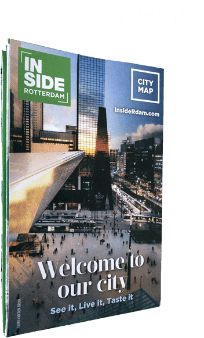The ‘hardy’ man’s haven
Rotterdam is world-famous for its international port. But nowadays its very first port, in Oude Haven, is now a busy entertainment hub and somewhere where you can watch ‘hardy’ men restoring their boats.
Words: Evelien Baks
Not that long ago, men used to traipse around the docks at Haringvliet dragging heavy loads on hunched-over backs. For centuries, ships moored here at Rotterdam’s Oude Haven. Stately merchant dwellings once stood here and money rolled in to the lively precinct.
That all came crashing down in 1940 when the World War II bombardment of May 14th reduced the city to a pile of smoking rubble, leaving only the Witte Huis and a handful of houses standing it this location. In one fell swoop, all activity at the Oude Haven came to an abrupt end; the same vibrant location where the grand Hotel Weimar had welcomed many foreign visitors to the land and where, in 1914 at the beginning of World War I, Tomáš Garrigue Masaryk (who later became Czechoslovakia’s first President), presented his famous lecture on his vision for Europe to the allies.
It took 45 years after the bombardment for houses to once again rise up around the small port, which now lay sandwiched between the Blaak and the Maasboulevard. The surviving 45-metre tall Witte Huis was built towards the end of the 19th century by two Rotterdam brothers who were inspired to build it after a visit to New York. Europe’s first skyscraper at the time, it is now half hidden behind what one would term real skyscapers these days, though it has not lost its charm. Its 100,000 white glazed bricks and Art Nouveau decorations make it a very photogenic monument. Be sure to check out the building’s facade. The five large figures on it represent seafaring, progress, agriculture, trade and industry.
Sadly, the viewing platform on the 11th floor of the Witte Huis is not open to the public, but there are plenty of other attractions to see in this popular entertainment district. Directly opposite the Witte Huis, you will find the Koningspoort slipway; home to the workmen who spend hours polishing and hammering away on their historic boats, returning them to their former glory. If the gates are open, you are welcome to wander in. They are only too happy to chat with you about their restoration projects.
Across the way are new houses that were built in the 1980s, their foundations in the water, just like the original buildings that once stood there. Piet Blom, architect of the famous yellow cube houses, set out to recreate an area so beautiful and innovative that no one would ever dare bomb it again. His Oude Haven architecture is inspired by the area’s history. The Potlood (Pencil) building, for example, is a direct nod to old port towers.
Cross over the historic Spanjaards Bridge to find numerous restaurants that are particularly buzzing at the weekend. The bridge is said to be named in recognition of the Spanish general, Ambrogio Spinola. At some point in 1608 (during the 80-year Dutch War of Independence) he stood at the steps of Rotterdam’s town hall. The bridge, which was erected in the 19th century, marks the spot where he disembarked from his ship so many hundreds of years ago.
Also worth checking out is the Mariniersmuseum next to the Witte Huis, which houses 350 years of awesome Dutch history spread across three floors. The museum was recently named the province’s ‘best outing’ experience.
And now for something to drink! Check out Café Het Witte Huis in the old skyscraper. This brown café with a restaurant and a terrace at the water’s edge is nice to sit in when the weather is fine. There are plenty of other places to sit back and relax around the city’s oldest port, including a recently listed Michelin-star restaurant.















